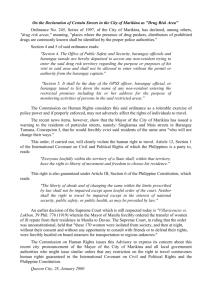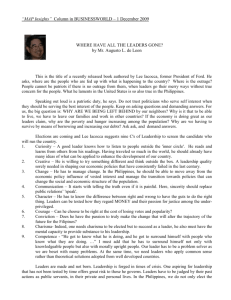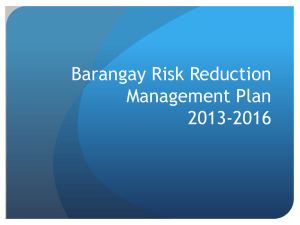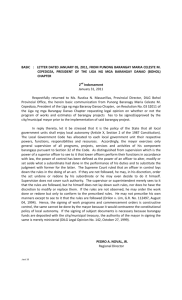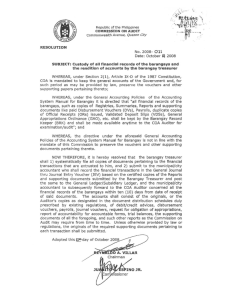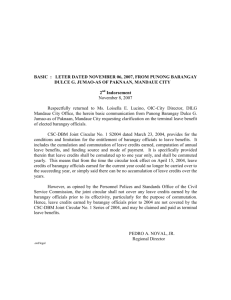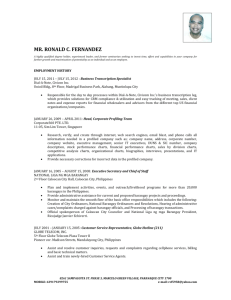Promotional Documentation
advertisement
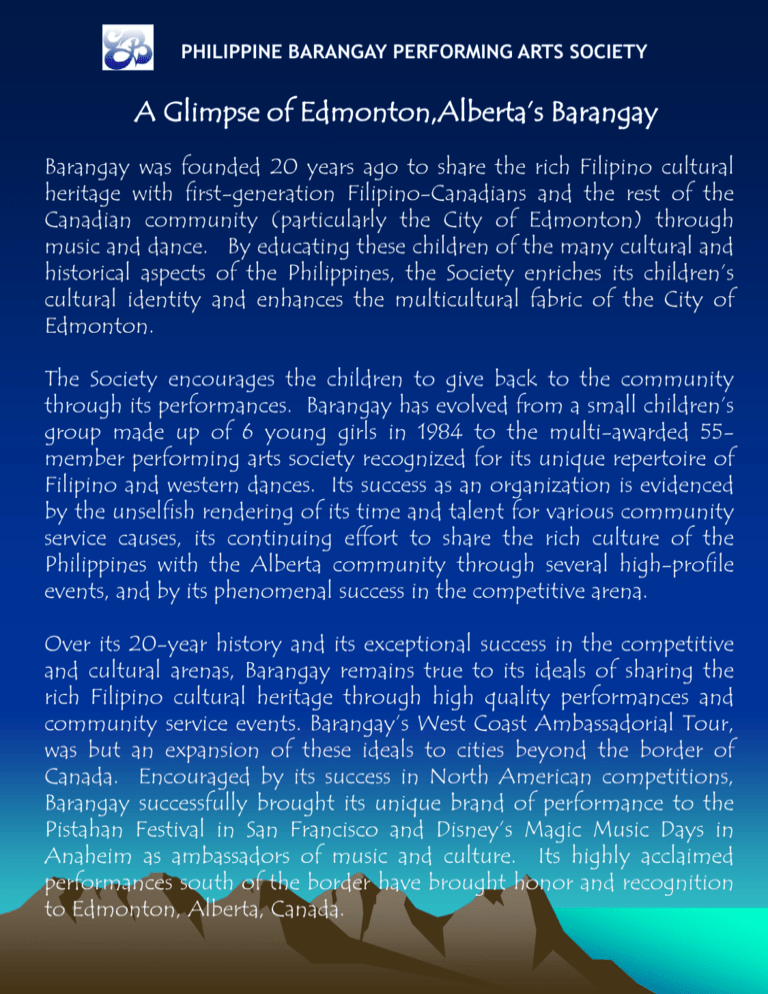
PHILIPPINE BARANGAY PERFORMING ARTS SOCIETY A Glimpse of Edmonton,Alberta’s Barangay Barangay was founded 20 years ago to share the rich Filipino cultural heritage with first-generation Filipino-Canadians and the rest of the Canadian community (particularly the City of Edmonton) through music and dance. By educating these children of the many cultural and historical aspects of the Philippines, the Society enriches its children’s cultural identity and enhances the multicultural fabric of the City of Edmonton. The Society encourages the children to give back to the community through its performances. Barangay has evolved from a small children’s group made up of 6 young girls in 1984 to the multi-awarded 55member performing arts society recognized for its unique repertoire of Filipino and western dances. Its success as an organization is evidenced by the unselfish rendering of its time and talent for various community service causes, its continuing effort to share the rich culture of the Philippines with the Alberta community through several high-profile events, and by its phenomenal success in the competitive arena. Over its 20-year history and its exceptional success in the competitive and cultural arenas, Barangay remains true to its ideals of sharing the rich Filipino cultural heritage through high quality performances and community service events. Barangay’s West Coast Ambassadorial Tour, was but an expansion of these ideals to cities beyond the border of Canada. Encouraged by its success in North American competitions, Barangay successfully brought its unique brand of performance to the Pistahan Festival in San Francisco and Disney’s Magic Music Days in Anaheim as ambassadors of music and culture. Its highly acclaimed performances south of the border have brought honor and recognition to Edmonton, Alberta, Canada. PHILIPPINE BARANGAY PERFORMING ARTS SOCIETY A Glimpse of Edmonton,Alberta’s Barangay This world-renowned national dance of the Philippines was named after the long-legged “Tikling” bird, which farmers attempted to trap in rice paddy fields. To relentlessly accelerating rhythm, dancers skillfully impersonate the tikling birds, and the magical movement of the birds’ feet skipping between striking and clicking bamboos. Barangay’s version of tinikling features complex choreography that requires dancers to dance between moving bamboo poles. PHILIPPINE BARANGAY PERFORMING ARTS SOCIETY A Glimpse of Edmonton,Alberta’s Barangay VINTA The settling of the Philippine Archipelago by pre-historic immigrants has been described as the greatest maritime feat ever: the crossing of the open seas in open boats. Vinta refers to the boat used by the Muslims. In this dance, dancers balance perilously on top of poles imitating the movements of the Vinta. PHILIPPINE BARANGAY PERFORMING ARTS SOCIETY A Glimpse of Edmonton,Alberta’s Barangay ANG PILIPINO AY TAYO This number illustrates the unity and diversity of the Filipino people. Clothed in the distinct traditional costumes of the Philippines’ three main regions (Luzon, Visayas and Mindanao), the performers dance in unison, their white garments signifying the oneness of their country’s rich heritage. PHILIPPINE BARANGAY PERFORMING ARTS SOCIETY A Glimpse of Edmonton,Alberta’s Barangay ITIK-ITIK Named after the Tagalog term for “duck”, this mimetic dance performed by the junior dancers of Barangay depicts the walking movements of ducks and the elbow to simulate wings. PHILIPPINE BARANGAY PERFORMING ARTS SOCIETY A Glimpse of Edmonton,Alberta’s Barangay Along with the extensive repertoire of folk and fusion dances, there has always been a strong emphasis of allowing Barangay’s young performers to express themselves through the music of their generation. Barangay’s hip-hop repertoire is recognized in North American Competitions through its numerous awards in the hip-hop genre. PHILIPPINE BARANGAY PERFORMING ARTS SOCIETY A Glimpse of Edmonton,Alberta’s Barangay SINGKIL This dance takes its name from the bells worn on the ankles of the Muslim princess. Perhaps one of the oldest of truly authentic of Filipino dances, the “Singkil” recounts the epic legend of the “Darangan” of the “Maranao” people of Mindanao. This epic tells the fateful story of Princess Gandingan, who was caught in the middle of a forest during an earthquake that was caused by the “diwatas” (or fairies of the forest). To this day, royal princesses in the Sulu Archipelago are required to learn this most difficult and noble dance.

